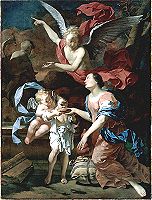Among them is a trio of great religious subjects Dujardin painted in Amsterdam, one of the major achievements of their kind in Dutch religious painting of the 17th c. Hagar & Ishmael is one; the other two are The Conversion of Saul and Peter Healing the Sick. Although he is best known for his bucolic visions of The Roman countryside, Dujardin painted a good number of religious and mythological scenes, particularly in the 1660s. Dujardin divided his career between Italy and Holland and studied under the Dutch Italianate painter Nicolaes Berchem in Rome. While living in Amsterdam in the late 1650’s he turned to history painting in the classical vein, then much in favor in Holland. SUBJECT: PAINTING: The angel, Hagar and the tree trunks are arranged in a massive “V” that dominates the tightly balanced composition. The hand positions tell the story…the angel’s right hand points to Heaven, the source of their help; the left gestures toward the spring that has miraculously appeared. Hagar’s left hand touches the empty water jug to indicate her plight, while her right hand holds the cup for Ishmael: her eyes acknowledge the heavenly source. Only Dujardin would think of including a small angel, just Ishmael’s size , to help him. HISTORIC CONTEXT: Many Dutch painters treated the subject of Hagar’s rescue, among them Rembrandt. It may be that part of the vogue was due to the 17th c. Dutch conception of women as either victims or victors, a recurrent theme in contemporary works. The various attitudes of different artists are interesting, ranging from the righteous ejection of a mistress and illegitimate son, to the portrayal of Abraham as a lecher accosting Hagar.
|
